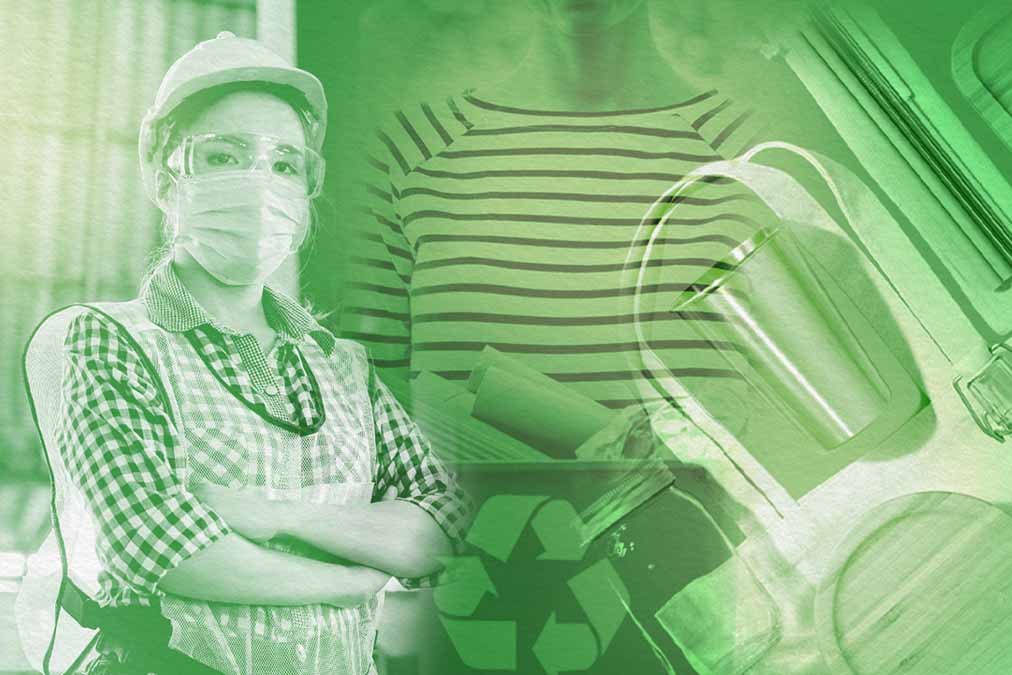
In this monthly series, we spotlight women moving us toward a circular economy.
Welcome back to “Women in Circularity,” where we spotlight women moving us toward a circular economy. This month, I connected with a sustainability professional who brought her passion for inclusive design to a global corporation: Sarah Enaharo, MSc, LEED AP. Sarah is the director of global sustainability at the floor covering division of Milliken & Company, which is an industrial manufacturer active across a breadth of disciplines, including specialty chemicals, floor covering and textiles. Sarah also serves as a member of the board for the National Center of Healthy Housing, a member of the U.S. Green Building Council (USGBC) Leadership in Energy and Environmental Design (LEED) Steering Committee, and a member of the Healthy Equity Advisory board of the International WELL Building Institute.
Sarah Enaharo
How did you shape your career path in this field?
I have been purposeful in the experience I wanted to gain over the years. In my 20s, I obtained a foundational knowledge of sustainability through internships with Anacostia Watershed Society (water stewardship) and District of Columbia Sustainable Energy Utility (energy efficiency and policy). In order to learn project management skills and LEED, I worked for a general contractor. I pivoted into building product manufacturing to learn how products impact indoor air quality and sustainable business practices. Incorporating more strategy and big thinking to my project management experience is a value add. Growing my network has also led to many impactful partnerships. Communication and writing were skills I strengthened over the years. Public speaking opportunities have grown and volunteer experiences have evolved from committee level to national boards.
Looking at the ‘toolkit’ you’ve developed from past jobs, which item do you use daily?
Communicating technical information to non-technical audiences. As the community outreach associate at DC Sustainable Energy Utility, I had to communicate what energy efficiency was and its value to underserved communities. I didn’t realize at the time the importance of gaining buy-in from stakeholders and influencing leaders. It’s necessary to advance sustainability. My lesson learned is to be attentive to your audience and to meet people where they are.
What will most impact circularity in the near-term?
Consumer education on take-make-waste. Incorporating circular design early in a product’s development. Investment in manufacturing processes to deconstruct products.
What work-related initiative most affected you and why?
Currently, I’m excited to be helping with the construction of the Tamir Rice Afrocentric Cultural Center in Cleveland. The property is being transformed by Robert P. Madison International (RPMI) and AKA Team into a multi-use facility for local youth to celebrate people of African descent. When told about the project by my mentor Ariane Kirkpatrick, I said, “I can donate flooring, but how else can I help?” Ariane connected me with Sandra Madison of RPMI, and while discussing the design, I inquired about their plan to incorporate green building products and to certify in order to create a healthy community space. The intent was there, but the budget was tight. While catching up with my friend Jennifer Sheffield, who works for WAWA Sustainable Architecture and who shares my passion for equity and inclusive design, her response was “How can I get involved?” With Jennifer’s help, we approached the U.S. Green Building Council about partnering with us to ensure LEED certification was feasible for this worthwhile project. They were also on board! What’s exciting is the impact one can have on the community by tapping into one’s network. As a sustainability practitioner, I’m passionate about exposing underserved youth to green building and STEM careers. I’m honored to be able to do so.
What is a favorite piece of advice you’ve received from a mentor?
“Step into life confidently, never forgetting who you are and whose you are. Remember the true source of your strength and blessings.” – Sharon Robinson (my mom)
What career development opportunities do you recommend to other sustainability professionals?
For educational courses and professional credentials that provide a foundation for sustainable-building design and energy management, check out the Association of Energy Engineers, which runs the Certified Energy Manager (CEM) and Certified Energy Auditor (CEA) certifications; the International Society of Sustainability Professionals (ISSP), which has the Sustainability Excellence Associate (SEA) and Sustainability Excellence Professional (SEP) programs; the Green Building Initiative, which has the Green Globes Emerging Professional (GGEP) and Green Globes Professional (GGP) programs; and the USGBC, which has the LEED Green Associate and LEED Advanced Professional credentials.
To understand the link between material sustainability and a company’s ability to drive enterprise value, the Sustainability Accounting Standards Board (SASB) offers a Sustainability Accounting credential. For leadership development, take a look at the Leading the Sustainability Transformation certification by the GreenBiz Group. Volunteering for boards helps build strategic thinking and communication skills and offers networking opportunities. Growing industry relationships is key.
MaryEllen Etienne is the creator of “Women in Circularity.” Etienne works on the Market Transformation and Development team for the U.S. Green Building Council. She has over 20 years of experience in sustainability and is a champion of the circular economy.
More from the “Women in Circularity” series
- Women in Circularity: Teresa Bradley
- Women in Circularity: Sue Beets-Atkinson
- Women in Circularity: Beth Forsberg